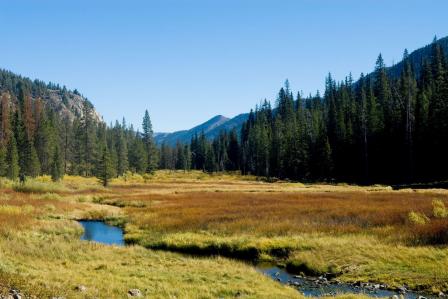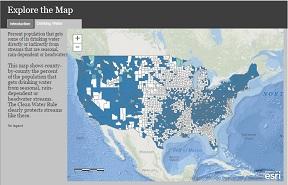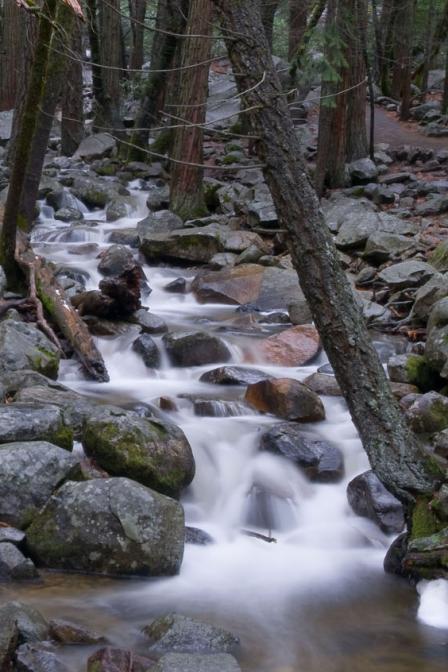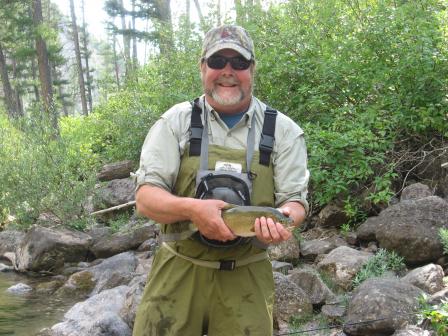Streams under CWA Section 404
Small streams, including those that don’t flow all of the time, make up the majority of the country’s waters. They could be a drizzle of snowmelt that runs down a mountainside crease, a small spring-fed pond, or a depression in the ground that fills with water after every rain and overflows into the creek below. These water sources, which scientists refer to as headwater streams, are often unnamed and rarely appear on maps. Yet the health of small streams is critical to the health of the entire river network and downstream communities. These small streams often appear insignificant, but in fact are very important, as they feed into and create our big rivers.
Types of Streams
Like the photos on this page? Visit our Flickr Gallery to see more streams.![]()
 Headwater streams are the smallest parts of river and stream networks, but make up the majority of river miles in the United States. Headwater streams are the beginnings of rivers, the uppermost streams in the river network furthest from the river's endpoint or confluence with another stream. Headwater streams trap floodwaters, recharge groundwater supplies, remove
Headwater streams are the smallest parts of river and stream networks, but make up the majority of river miles in the United States. Headwater streams are the beginnings of rivers, the uppermost streams in the river network furthest from the river's endpoint or confluence with another stream. Headwater streams trap floodwaters, recharge groundwater supplies, remove
pollution, provide fish and wildlife habitat, and sustain the health of downstream rivers, lakes and bays. Because small streams and streams that flow for only part of the year are the source of the nation’s fresh waters, changes that harm these headwaters affect streams, lakes and rivers downstream.
Headwaters can be streams that flow briefly when snow melts or after rain, but shrink in dry times to become individual pools filled with water. Desert headwater streams can arise from a spring and run above ground only a few hundred yards before disappearing into the sand. Other spring-fed headwaters contain clear water with steady temperature and flow. Yet other headwaters originate in marshy meadows filled with sluggish tea-colored water.
Headwater streams and streams that only flow for part of the year make up the majority of river miles in the United States. About 53 percent of the total stream miles in the continental U.S. are headwater streams. Almost 60 percent of stream miles in the continental U.S only flow seasonally or after storms. The very foundation of our nation’s great rivers is a vast network of unknown, unnamed and underappreciated streams. Flow in a headwater may be year-round, seasonal, or rain-dependent.
Year-round streams (perennial) typically have water flowing in them year-round. Most of the water comes from smaller upstream waters or groundwater while runoff from rainfall or other precipitation is supplemental.
 Click on the map above to see the percentage of people in your county that gets some of their drinking water directly or indirectly from streams that are seasonal, rain-dependent or headwaters.Seasonal streams (intermittent) flow during certain times of the year when smaller upstream waters are flowing and when groundwater provides enough water for stream flow. Runoff from rainfall or other precipitation supplements the flow of seasonal stream. During dry periods, seasonal streams may not have flowing surface water. Larger seasonal streams are more common in dry areas.
Click on the map above to see the percentage of people in your county that gets some of their drinking water directly or indirectly from streams that are seasonal, rain-dependent or headwaters.Seasonal streams (intermittent) flow during certain times of the year when smaller upstream waters are flowing and when groundwater provides enough water for stream flow. Runoff from rainfall or other precipitation supplements the flow of seasonal stream. During dry periods, seasonal streams may not have flowing surface water. Larger seasonal streams are more common in dry areas.
Rain-dependent streams (ephemeral) flow only after precipitation. Runoff from rainfall is the primary source of water for these streams. Like seasonal streams, they can be found anywhere but are most prevalent in arid areas.
Despite their seasonal or temporary appearance on the landscape, seasonal and rain-dependent streams are critical to the health of river systems, are hydrologically and biologically connected to the downstream waters, and provide many of the same functions and values as rivers and larger streams. The arid Southwest and Midwest portions of the country have the highest number of seasonal and rain-dependent streams. For example, more than 95 percent of the streams in Arizona are seasonal.
- Learn more about the extent of seasonal and rain-dependent streams across the U.S.
- The Ecological and Hydrological Significance of Ephemeral and Intermittent Streams in the Arid and Semi-arid American Southwest
Channels are natural or artificial open areas that connect two bodies of water and may have water flowing in them continuously or periodically.
Arroyos are small, deep, flat-floored channels of a seasonal or rain-dependent stream, usually with nearly vertical banks cut into soil and sediment, rather than rock. Arroyos are most often found in the arid and semiarid regions of the United States.
Sloughs are small, marshy stretches in a swale or shallow undrained depression, or slow-moving creeks or channels in a wetland.
Importance of Streams
Streams, headwaters and streams that flow only part of the year provide many upstream and downstream benefits. They protect against floods, filter pollutants, recycle potentially-harmful nutrients, and provide food and habitat for many types of fish. These streams also play a critical role in maintaining the quality and supply of our drinking water, ensure a continual flow of water to surface waters, and help recharge underground aquifers.
 Small streams, headwaters, and streams that flow only part of the year protect against floods, filter pollutants, and provide food and habitat for many types of fish.
Small streams, headwaters, and streams that flow only part of the year protect against floods, filter pollutants, and provide food and habitat for many types of fish.
Clean drinking water
Streams play a critical role in the quality and supply of our drinking water by ensuring a continuous flow of clean water to surface waters and helping recharge underground aquifers. In the continental United States, 357,000 miles of streams provide water for public drinking water systems. Of that total, 58 percent (more than 207,000 miles) are headwater streams. Approximately 117 million people– over one-third of the total U.S. population – get some or all of their drinking water from public drinking water systems that rely in part on these streams.
See: geographic analysis of surface drinking water provided by headwater streams.
Flood and erosion protection
Headwaters, seasonal streams and rain-dependent streams absorb significant amounts of rainwater, runoff and snowmelt before flooding. These streams have significant storage ability and play a critical role in protecting downstream communities by moderating flooding during heavy flow and by maintaining flow during dry weather. Over the last 30 years, freshwater flooding has cost an average of $7.8 billion in direct damage to property and crops each year.1
Groundwater recharge
Streams are also vital for recharging the nation’s groundwater supply. Water enters the groundwater through the stream bed. Even during dry periods, groundwater replenishes flow in the stream to feed downstream waterways. In arid regions, water from rain-dependent and seasonal streams supports springs, wetlands and plants far from the recharge areas. A major source of water in rivers in the Southwest is from groundwater released into streams that only flow part of the year.
Pollution reduction
Streams can reduce the pollution that flows to downstream rivers, lakes, bays, and coastal waters. They are able to retain sediments and excess nutrients, such as nitrogen and phosphorus, and prevent these pollutants from traveling further downstream where they could cause algal blooms or dead zones.
Wildlife habitat
Streams that only flow for part of the year are unique and diverse habitats that can support thousands of species, including plants, fish, amphibians, birds and mammals. These streams are important as spawning and nursery habitats, seasonal feeding areas, refuge from predators and competitors, shelter from extreme weather and travel corridors. Many stream species, including fish, snails, crayfish, insects and salamanders, are now in danger of extinction as a result of human actions. A few dozen species are already listed under the U.S. Endangered Species Act; hundreds of others are rare enough to be considered for listing.
Streams that flow for only part of the year provide crucial habitat, food and water for plants and wildlife. In the arid West, vegetation and wildlife near these streams – which often have water flowing just below the surface even when the surface looks dry – is significantly higher than in the surrounding uplands.
Economic importance
See: how wetlands support fishing and hunting.
- Fishing: About 33 million anglers spend $41.8 billion annually on trips, equipment, licenses, and other items to support their fishing activities. The commercial salmon fishery, worth an estimated $555 million in 2010, depends on small streams- and streams that do not flow year round- which serve as spawning areas for salmon as far as 900 miles inland.2
 Healthy streams and headwaters support many industries that are dependent on clean water.
Healthy streams and headwaters support many industries that are dependent on clean water. - Hunting: About 2.6 million people per year hunt migratory birds, which depend on healthy wetlands, spending more than $1.8 billion dollars per year in the process.3
- Manufacturing: Industries use fresh water to process, wash, cool, dilute, and manufacture products. Manufacturing used more than 6.6 trillion gallons of fresh water in 2005. 4
- Agriculture: Farmers depend on clean water to irrigate farm crops across the country. Irrigation accounts for 37 percent of all surface freshwater withdrawals in the U.S.5
View sources of this information under 'Rivers and Streams' in EPA's Archive.
Additional Resources
- EPA Field Operations Manual for Assessing the Hydrologic Permanence and Ecological Condition of Headwater Streams
- The Ecological and Hydrological Significance of Ephemeral and Intermittent Streams in the Arid and Semi-arid American Southwest
- Final Report: Connectivity of Streams and Wetlands to Downstream Waters: A Review and Synthesis of the Scientific Evidence
- EPA Office of Research and Development Headwater Streams page
- Streamflow Duration Assessment Method for the Pacific Northwest
